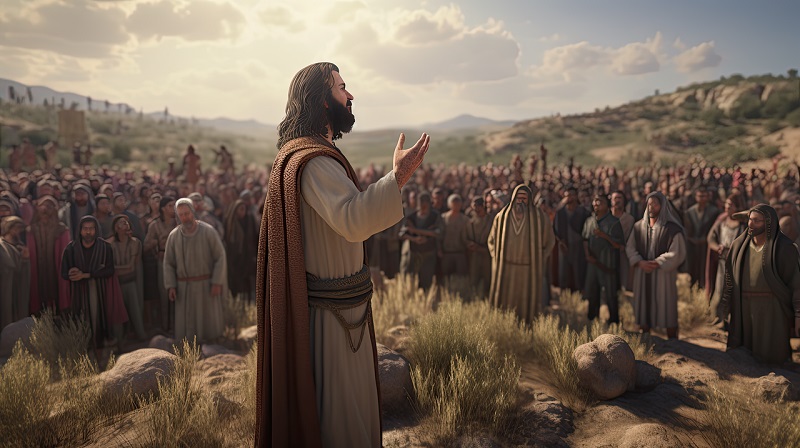Although the Bible is primarily regarded as a source of hope, it also contains shocking examples of bad news that can’t be overlooked.
These stories of loss, despair, and divine judgment provide a stark contrast to the messages of love and redemption, making them crucial for our understanding of faith.
This article highlights key instances of bad news in the Bible, encouraging readers to reflect on the lessons and enduring relevance they hold in our lives.
Prepare to confront these challenging narratives and discover their hidden strengths.
✅ The 5 Examples of Bad News in the Bible

Examining these examples helps believers understand the lessons behind negative events and the importance of faith, obedience, and discernment in responding to life’s challenges.
1. The Fall of Man: The First Bad News
The Fall of Man serves as a poignant reminder of the weight of choices and their consequences.
When Adam and Eve disobeyed God, they didn’t just disrupt their own lives; they set into motion an entire narrative of human experience characterized by struggle and separation.
This initial act of defiance unleashed a ripple effect, echoing through generations and illustrating how seemingly small decisions can lead to widespread ramifications.
The repercussions of their actions — suffering, toil, and alienation from the divine — emphasize that bad news originates from a fundamental disconnect from God’s will.
Throughout the Bible, we see echoes of this theme, as reflected in various examples of bad news, such as Cain’s murder of Abel or the Israelites’ exile in Babylon.
Each story underscores the idea that sinful choices bear fruit, often in ways that affect entire communities.
However, nestled within these narratives is also the hope for redemption.
The Fall of Man is not merely a tale of despair; it invites us to reflect on our own choices and to recognize the profound impact they have on our lives and the wider world.
Ultimately, it challenges us to seek alignment with God’s intentions, paving the way for restoration amid adversity.
2. The Flood: Judgment Announced
The story of the Flood carries profound lessons about the dual nature of divine revelations — warnings that can seem devastating but ultimately lead to preservation.
In Genesis 6–9, God’s announcement of the Flood highlights how bad news can serve a larger purpose.
While it condemned an era of corruption and violence, it also provided Noah with a blueprint for survival, showcasing God’s desire for redemption amid judgment.
This mirrors other examples of bad news in the Bible, such as the foretelling of the Babylonian exile, which served to awaken a slumbering nation and realign their hearts with divine will.
Noah’s obedience in the face of distressing news underscores the importance of faith-driven action during turbulent times.
Instead of succumbing to despair, he built an ark — a tangible response to God’s instructions.
This invites reflection on how we, too, may be called to prepare in our own lives when faced with unsettling messages, whether through personal trials or societal upheavals.
The Flood reminds us that divine communication, even when unsettling, ultimately aims to guide us toward righteousness and restoration, challenging us to remain steadfast in our faith as we navigate our own storms.
3. The Fall of Jericho: Defeat and Destruction
The fall of Jericho stands as a striking example of how stories of bad news in the Bible often serve as catalysts for transformation.
While the walls crumbled and the city faced utter destruction, for the Israelites, this was a powerful validation of their faith.
The command to march in silence and the subsequent shout reverberated not just through the landscape but into the hearts of those who believed.
This experience underscores the notion that sometimes, divine justice unfolds in ways that seem harsh, yet they are rooted in an overarching narrative of hope and promise.
However, the fate of Jericho also cautions against complacency in faith.
The inhabitants were unaware of the looming consequences until it was too late, a poignant reminder that ignoring warnings can lead to dire outcomes.
Their silence in the face of impending doom contrasts sharply with the Israelites’ disciplined obedience — a testament to the power of vigilance and trust in God’s plan.
In a world where bad news often feels overwhelming, Jericho’s story invites us to reflect on our own responsiveness to divine messages, urging us to stay alert and faithful amid chaos and uncertainty.
4. Prophetic Warnings: Messages from the Prophets
The stories of bad news in the Bible, particularly from prophets like Jeremiah, Isaiah, and Ezekiel, serve as profound reminders of the weight of accountability in our spiritual journeys.
Through their powerful messages, these prophets were not mere harbingers of doom but catalysts for change, compelling communities to confront their sins and the idols they clung to.
For instance, Jeremiah’s cries of impending judgment were laced with an urgency for repentance, illustrating that even the harshest warnings were steeped in divine love and a longing for restoration.
These prophetic voices challenge us to view “bad news” through a transformative lens.
Instead of viewing these admonitions solely as threats, they can be seen as invitations to examine our lives and realign with God’s commands.
This perspective shifts our understanding of accountability from a punitive measure to a pathway toward spiritual growth and renewal.
Embracing the discomfort of these messages can lead to profound personal transformation, fostering resilience and a deeper connection to the divine.
Ultimately, acknowledging that bad news can herald a new beginning invites believers to engage in a dialogue about faith that fosters awareness, responsibility, and hope.
5. The Crucifixion: Bad News Leading to Redemption
The announcement of Jesus’ impending crucifixion in Luke 22–23 stands as one of the most jarring examples of bad news in the Bible, shattering the hopes and dreams of His disciples.
This despair, however, set the stage for an extraordinary transformation; from tragedy springs triumph.
The Crucifixion paints a powerful portrait of how God can weave the darkest moments into the fabric of divine redemption, inviting us to rethink our understanding of suffering and loss.
Consider other biblical events steeped in calamity, like Joseph’s betrayal by his brothers or Job’s harrowing trials.
Each instance initially appears as overwhelming misfortune, yet ultimately reveals a purpose that contributes to greater good.
The deaths and challenges faced become catalysts for restoration and understanding, illustrating that despair can lead to newfound hope.
The message of the Crucifixion reminds us that in life’s most profound struggles, God’s redemptive plan may be at work, turning our darkest hours into a pathway for light and faith.
Examples of Bad News in the Bible (Summary)
The Bible provides numerous examples of bad news to teach, warn, and guide God’s people.
From the Fall of Man to the Flood, the fall of Jericho, prophetic warnings, and the Crucifixion, each instance demonstrates that negative events carry lessons for spiritual growth, faith, and obedience.
These stories encourage believers to interpret bad news not merely as misfortune, but as a tool for learning, reflection, and alignment with God’s will.
Responding wisely to bad news involves recognizing God’s purposes behind the event, maintaining faith, and taking corrective action when needed.
By studying these biblical examples, modern believers can develop resilience, discernment, and spiritual maturity.
Ultimately, understanding the role of bad news in Scripture reinforces the importance of trust in God’s plan, patience in adversity, and the proactive pursuit of righteousness.
By applying these lessons, individuals can navigate challenges with hope, integrity, and confidence that God’s guidance leads to ultimate good.
FAQs About Bad News in the Bible
1. What are examples of bad news in the Bible?
Examples include the Fall of Man, the Flood, the destruction of Jericho, prophetic warnings, and the Crucifixion of Jesus.
2. What lesson does the Fall of Man teach?
The Fall teaches that disobedience and sin have consequences, affecting both individuals and the world around them.
3. How did the Flood serve as bad news?
The Flood warned of God’s judgment on a corrupt world, teaching obedience and preparation for divine intervention.
4. What role did prophetic warnings play in the Bible?
Prophets delivered bad news to encourage repentance, spiritual growth, and adherence to God’s commands.
5. Can bad news in the Bible have a positive purpose?
Yes, events like the Crucifixion show that even devastating news can serve God’s greater plan, leading to redemption and spiritual lessons.
Other Blog Posts
- 5 Examples of Bad Leaders in the Bible
- 5 Examples of Bad Influences in the Bible
- 21 Bible Verses About Anger

Grounded in faith and driven by purpose, I’m a Christian blogger and online research specialist with a passion for God’s Word, lifelong learning, and healthy living.
